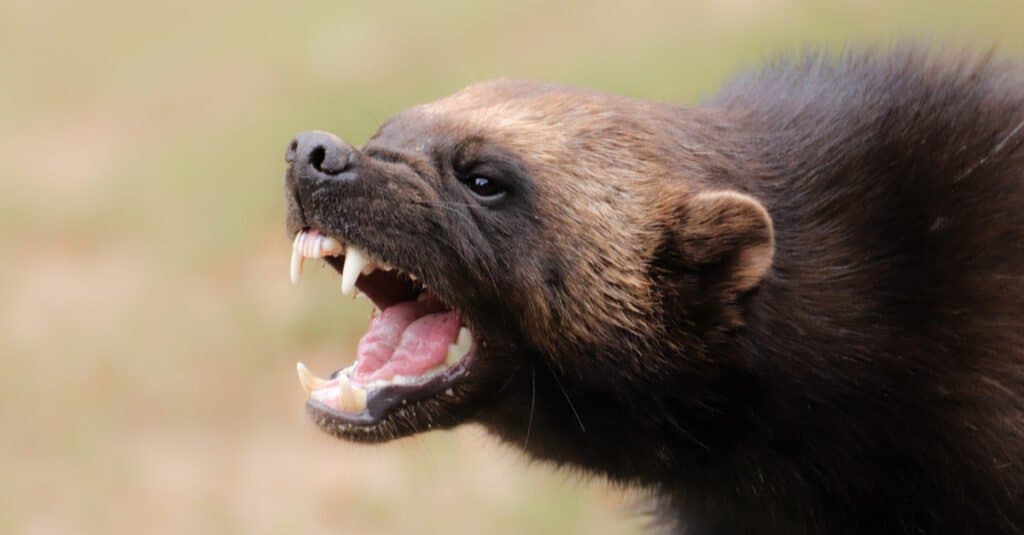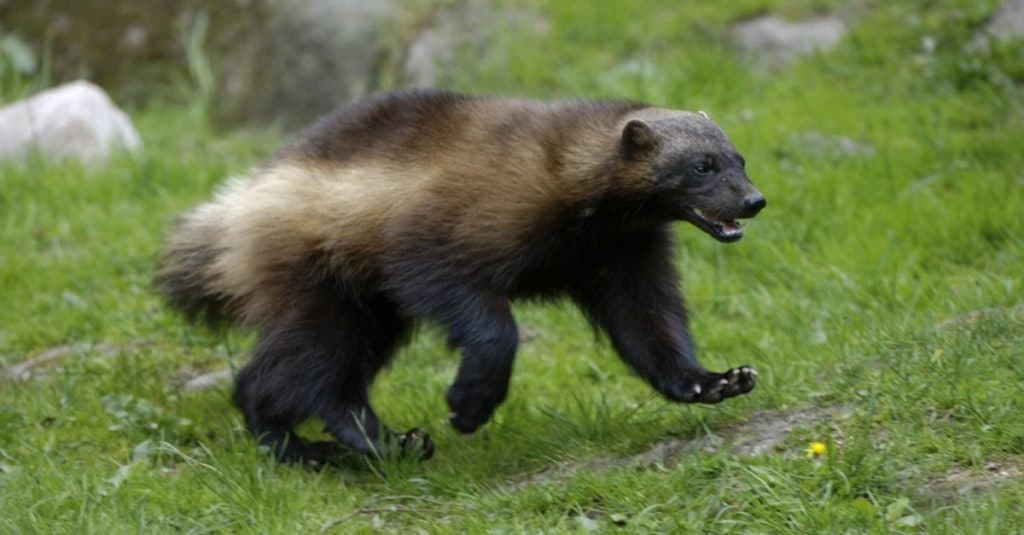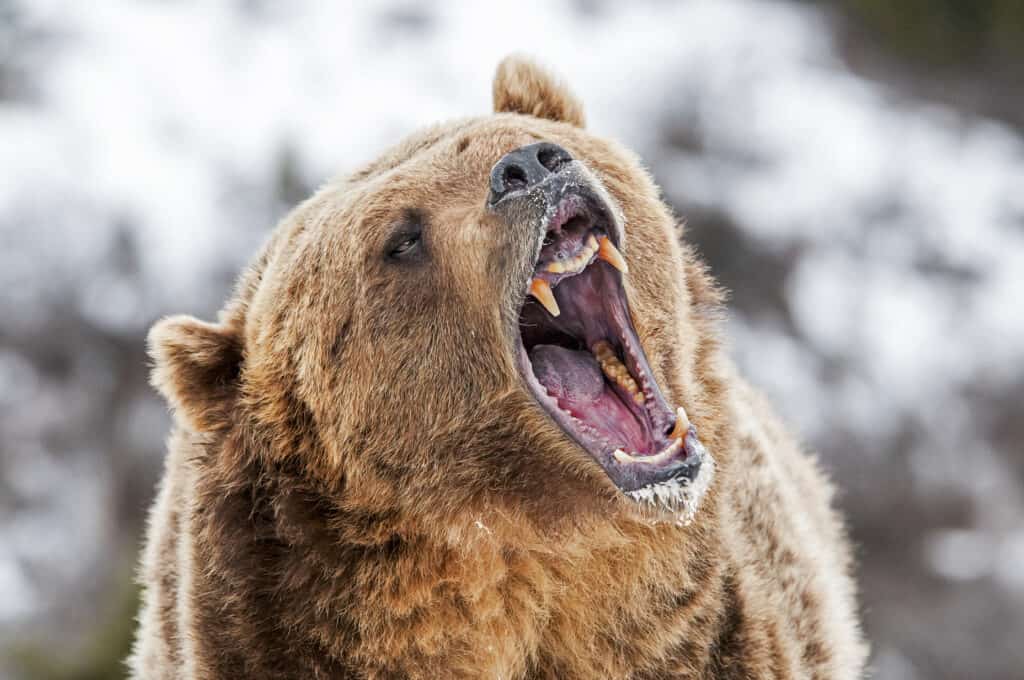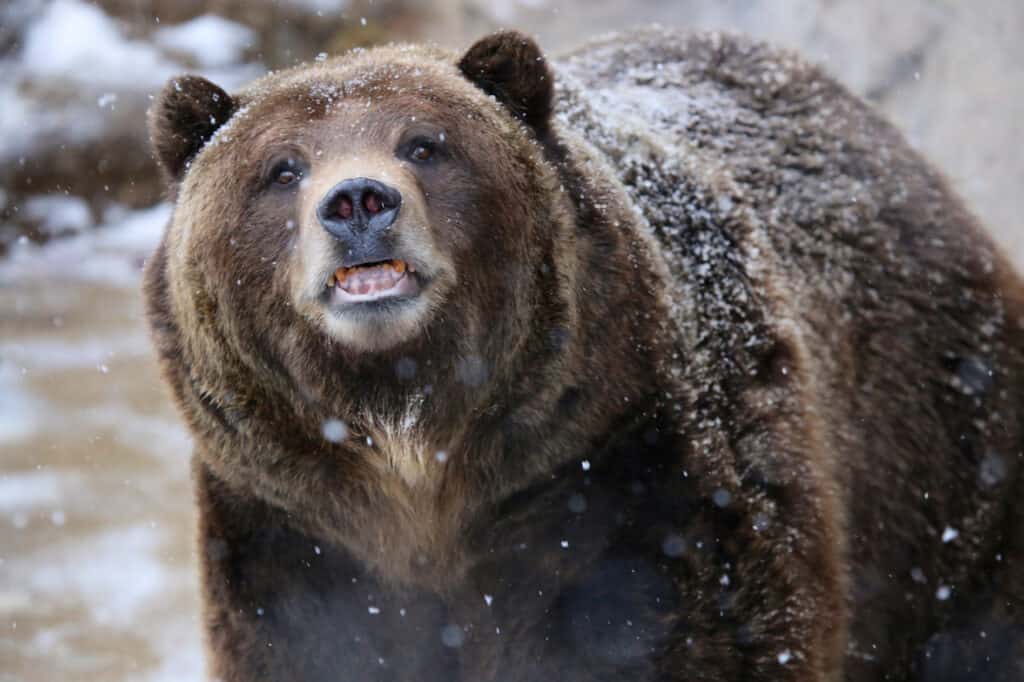Wolverines are known for being tenacious, deadly, and solitary creatures. Eyewitness accounts of them scaring off wolves and bears from their kills are not uncommon. However, we have to wonder how a wolverine would fare against one of the biggest bears, a grizzly.
To make things fair, we’ll give the wolverine some friends. That’s right, while wolverines don’t naturally travel in packs, today they are, and we’re going to pit the wolverine pack vs. a grizzly bear and see which of these ferocious mammals comes out on top!
Comparing a Wolverine Pack and a Grizzly Bear
| Categories | Wolverine Pack | Grizzly Bear |
|---|---|---|
| Size | – Weight: 22 to 70 pounds – Height: 1 to 1.5 feet – Length: 2.1 to 3.5 feet | – Weight: between 400 and 700 pounds, upwards of 1,200 pounds – Height: measures 3 to 4.5 feet – Length: grows 7 feet to 10 feet long |
| Speed | – up to 30 mph | – Can reach speeds of 35 mph on land – May swim around 6 mph |
| Defenses | – Each creature has somewhat thick fur – Numerous members of the pack decreases the chances of an individual getting killed – They can use their smelly musk to make creatures flee – Can hide in small spaces to escape predators | – The bear’s large size scares off most challengers – The bluff charge of the grizzly can dissuade attackers – Grizzlies have thick skin to protect against bites – Can traverse land and water to escape danger |
| Offensive Capabilities | – Use claws and teeth to attack – Have a bite power of about 50 PSI – Have strong teeth with molars that are made to crush bones and help them tear meat | – Uses a powerful combination attack of speed, biting, smacks, and slashes to kill prey – Has a bite force of 975 PSI – Their longest teeth measure 3 inches in length but average 1 inch – Has large paws with 4-inch claws that are used for digging – Mauling attacks combine their bites, claws, weight, and speed |
| Predatory Behavior | – Opportunistic feeders and hunters – Scavengers | – Grizzlies are opportunistic predators – Once they sense prey, they’ll relentlessly pursue it – They also scavenge food |
What Are 2 Key Differences Between a Wolverine Pack and a Grizzly Bear?

Wolverines are ferocious creatures and they are known to scare bears away from kill sites.
©DenisaPro/Shutterstock.com
The biggest differences between a wolverine pack and a grizzly bear are found in the size of the individual creatures and the way they attack prey. Grizzly bears are far larger than the individuals in a wolverine pack, and they use a more complex form of attack to kill their prey.
The average grizzly weighs between 400 and 700 pounds with the potential to grow even heavier, stands 3 to 4.5 feet tall, and measures up to 10 feet long, but the wolverines only weigh between 22 and 70 pounds, stand 1.5 feet tall, and grow 3.5 feet long.
Meanwhile, wolverines mostly depend on their bites to kill prey, but grizzly bears use a multifaceted mauling attack that makes use of their powerful bites, smashing attacks with their paws, slashes with claws, and their tremendous weight to kill prey.
These are some of the biggest differences between a wolverine pack and a grizzly bear. However, other differences exist, and we’ll explain some of them as we explore the important factors of this battle.
What Are the Key Factors in a Fight Between a Wolverine Pack and a Grizzly Bear?
We can’t just look at size alone as a factor to determine this fight. That being said, size is a factor. Other key factors in this battle will include predatory behavior, group size, offensive capabilities, defenses, and speed. We’ll weigh each of these elements, assign advantages to the appropriate creature, and use the information we’ve gathered along with a little imagination to name a winner!
Wolverine Pack vs. Grizzly Bear: Size
Grizzly bears are massive mammals that can weigh over 1,000 pounds in some cases. For the most part, they average a weight of 400 to 700 pounds, grow up to 4.5 feet tall on all four legs, and reach lengths of 10 feet long. However, an individual wolverine measures 22 to 70 pounds, stands 1.5 feet tall, and measures up to 3.5 feet long.
Grizzly bears have the size advantage over a wolverine pack.
Wolverine Pack vs. Grizzly Bear: Speed and Movement

Although grizzly bears are faster than wolverines, the smaller animals are more agile.
©Bildagentur Zoonar GmbH/Shutterstock.com
Wolverines are not slow animals. They can reach speeds of up to 30 mph which they often use to close the gaps when chasing down prey. Surprisingly, the heavy, thick-bodied grizzly bear is capable of reaching higher speeds. In fact, their running speed has been clocked at 35 mph, and they have more stamina than other creatures that size!
Grizzly bears are faster than wolverines, but wolverines are almost certainly more agile.
Wolverine Pack vs. Grizzly Bear: Defenses
Grizzly bears’ massive size is enough to make most animals think twice about attacking them. If they were brave enough to try, they would find out that the grizzly has very thick skin, hard bones, and a very dense body.
That’s not all grizzlies have going for them, though. Their bluff charge is enough to make most animals turn their tail and run. Even if they found themselves at a disadvantage, they can easily traverse land and water to find safety.
Meanwhile, the wolverine pack would find safety in numbers. Yet, their personal defenses are somewhat lacking in the face of the bear. They can produce musk and make animals less inclined to eat them, and they also have thick fur that can help protect them against some bites.
All in all, grizzly bears have better defenses compared to wolverines.
Wolverine Pack vs. Grizzly Bear: Offensive Capabilities

Grizzly bears have a powerful bite that can swiftly kill prey.
©Scott E Read/Shutterstock.com
Wolverines don’t have the most powerful attacks in the world. Their bite power is about 50 PSI, but their specialized teeth help them break bones and rend flesh. Moreover, they have claws that can be used for fighting as well as for digging. In a group, though, those small bites can become more dangerous.
Meanwhile, grizzly bears are a powerhouse when it comes to fighting. They have a strong bite that measures 975 PSI, somewhat dull claws that can still slash prey, and large paws that can be used to swat prey and knock it down or out.
Their 3-inch teeth can deal fatal damage to the neck, back, and head of their enemies as well. They like to use their attacks in a brutal combination called mauling. They’ll use their body weight to pin enemies, bite them, smash them with their paws, or hold them with their teeth and vigorously shake them.
Grizzly bears have an advantage over wolverines in terms of offensive capabilities.
Wolverine Pack vs Grizzly Bear: Predatory Behavior
Both grizzly bears and a wolverine pack would hunt in similar ways. They are opportunistic predators that sense prey and then pursue it. They’ll range for long distances to find food. When they aren’t hunting, they are scavenging, and that sometimes brings them into close contact with humans.
Wolverines and grizzlies are tied in their approach to finding prey.
Who Would Win in a Fight Between a Wolverine Pack and a Grizzly Bear?

With their powerful bodies and fierce nature, grizzly bears would win a fight against a pack of wolverines.
©Perpis/Shutterstock.com
A grizzly bear would win a fight against a wolverine pack with about five members. The most likely way this fight starts is a wolverine pack and grizzly bear fighting over food. If the animals absolutely decided to commit to the fight, the wolverines would have very few ways of killing a grizzly bear. They’re so much smaller than the grizzly, have a relatively weak bite, and have no coordination with their fellow group members.
Some people may be inclined to buy into the idea that a wolverine only needs to run down a grizzly bear and bite its jugular vein to swiftly kill the creature. The chances of that happening are very low. Although they may be starving, their instincts will be screaming for them to let another wolverine take the lead so as not to rush into the jaws of a bear.
Wolverines are solitary creatures. We can’t expect them to become a coordinated strike force. More than likely, the grizzly bear would start off by charging and mauling one member of the group, making a few of the others scramble.
They could certainly harass the grizzly, biting at its legs, underside, and anywhere else they could reach. However, their bites will meet serious resistance from the bear’s thick fur and skin, not causing enough damage to seriously hinder the grizzly. Meanwhile, the grizzly would pin victim after victim, biting it, and shaking it before delivering a single, fatal bite to the back, neck, or head.
Unless the wolverines got very lucky or could simultaneously attack at vulnerable spots on the bear without getting killed, they don’t stand much of a chance. However, if a larger group, say 12 attacked a grizzly, they would win but probably by making the bear flee.
Is it Normal for Wolverine Packs and Grizzly Bears to Fight?

Grizzly Bear Close up with snow
©Steve Boice/Shutterstock.com
Wolverines are known to be highly territorial animals and will defend their home range against other wolverines, as well as potential threats like wolves and cougars. They are also known to scavenge on carrion, which could potentially bring them into conflict with grizzly bears that are feeding on the same food source.
Grizzly bears are much larger and more powerful than wolverines and are known to be aggressive defenders of their territory and food sources. While they are typically solitary animals, they may occasionally come into contact with other grizzly bears or other predators like wolves or cougars.
In the rare instances where wolverines and grizzly bears do come into direct conflict, it is difficult to predict who would come out on top. While grizzly bears are much larger and more powerful than wolverines, wolverines are known for their strength, tenacity, and ability to fight off predators much larger than themselves.
The outcome of any such conflict would likely depend on a variety of factors, including the size and age of the animals involved, the circumstances of the encounter, and other environmental factors.
The photo featured at the top of this post is © Scott E Read/Shutterstock.com
Sources
- Nature Works, Available here: https://nhpbs.org/natureworks/wolverine.htm#:~:text=The%20wolverine%20is%20very%20quick,that%20keeps%20other%20animals%20away.
- Science Daily, Available here: https://www.sciencedaily.com/releases/2003/05/030506073236.htm
- Alaska Department of Fish and Game , Available here: https://www.adfg.alaska.gov/index.cfm?adfg=wildlifenews.view_article&articles_id=692
Thank you for reading! Have some feedback for us? Contact the AZ Animals editorial team.






